Published in 1976—a full six months prior to the release of the film it was adapting—the novelization of Star Wars titled: Star Wars: From the Adventures of Luke Skywalker was billed as “a novel by George Lucas.” We now know (as Lucas freely admits in reprints of the book) that this book was in fact written by Alan Dean Foster, who created several specific aspects of the Star Wars backstory, many of which remain canon to this day. However, despite the wealth of terms and ideas that stuck, there are many, many differences between what we would come to know as Star Wars and what is contained in this book. Here are a few inconsistencies, differences and other curiosities originating from the first glimpse the public ever got of Star Wars.
Palpatine is Not a Sith Lord. Also, Not Even in Charge
In the film, an Imperial officer named General Tagge (didn’t even have to look that up) is moderately freaked out upon hearing that the “senate” has been dissolved. “How will the Emperor maintain control without the bureaucracy?” he worries. Well, in the prologue to the novel, the Emperor doesn’t. In a super-brief introductory section of the book (which claims to be taken from something called “The Journal of the Whills”) the death of the Old Republic and rise of the Empire is summarized quickly. Most interestingly, the rise of Palpatine from senator to President and then Emperor dovetails neatly with the events of the movie prequels. That is, until this casual assertion:
“Once secure in office he declared himself Emperor, shutting himself away from the populace. Soon he was controlled by the very assistants and boot-lickers he had appointed to high office, and the cries of the people for justice did not reach his ears.”
Palps is most certainly not a Sith Lord, nor does he even seem all that evil. Instead, he’s more like some creepy historical politician, like a Caesar being betrayed by a bunch of boot-licking Brutuses. Certainly not the cackling, all-knowing lightning-shooting guy we know so well. Also, how do we feel about the fact that the opening lines of the first ever item in the epic Star Wars franchise contains the phrase “boot-lickers?”
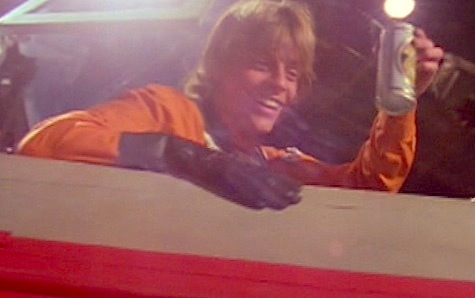
Gold Squadron? Never heard of them. Plus, big ups for Biggs!
Much of the rebel assault on the Death Star is depicted in the same manner as you see it in the film, but there are some changes. Superficially, the most noticeable differences are in the color designations. Instead of the Y-Wings being Gold Squadron, they’re Red Squadron, while the X-Wings of Red Squadron are now Blue Squadron. This means Luke is Blue 5 instead of Red 5. The drama of the battle itself plays out pretty much the same as in the film, but carries a slightly more somber tone.
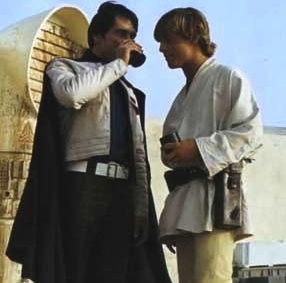 The friendship between Luke and Biggs is actually a big part of the Star Wars novel and, you could argue, helps to make Luke more realistic and relatable. This relationship is introduced in the beginning of the novel with the infamous deleted scene in which Luke observes the capture of the Tantive IV through his nifty space binoculars. Biggs is hanging out on Tatooine, and then shows up again twice more in the book. Right before the big battle they describe their friendship in terms of “two shooting stars,” a sentiment Luke repeats tearfully as Biggs dies tragically in his X-Wing. Further, it is Biggs and NOT Wedge who saves Luke’s ass from a TIE Fighter early in the battle. In the film, we mostly remember Biggs for his moustache. In the novel, he’s a real person.
The friendship between Luke and Biggs is actually a big part of the Star Wars novel and, you could argue, helps to make Luke more realistic and relatable. This relationship is introduced in the beginning of the novel with the infamous deleted scene in which Luke observes the capture of the Tantive IV through his nifty space binoculars. Biggs is hanging out on Tatooine, and then shows up again twice more in the book. Right before the big battle they describe their friendship in terms of “two shooting stars,” a sentiment Luke repeats tearfully as Biggs dies tragically in his X-Wing. Further, it is Biggs and NOT Wedge who saves Luke’s ass from a TIE Fighter early in the battle. In the film, we mostly remember Biggs for his moustache. In the novel, he’s a real person.
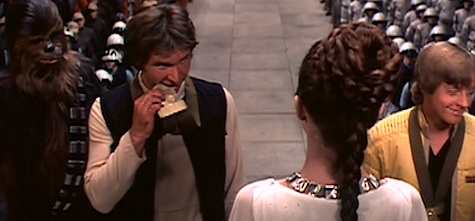
Chewbacca Gets a Medal!
Extensively parodied and complained about, the lack of a medal for Chewbacca is one of those small inexplicable events in Star Wars, on par with the gunners deciding not to shoot Threepio and Artoo’s escape pod in the beginning of the film. The Falcon requires two people to fly! And really, to run it properly, even more than that. So why didn’t Leia and those folks give Chewbacca a medal? Maybe they got the medals made beforehand and ran a statistical algorithm which told them that two survivors was the most likely outcome. Nobody wanted to spring for the extra medal, so Chewie was screwed. But in the book, he gets one, right before Luke.
Chewbacca shuffled nervously, giving every indication of wishing he were someplace else. Solo silenced him as Leia rose and came forward. At the same time banners tilted in unison and all those gathered in the great hall turned to face the dais.
She placed something heavy and golden around Solo’s neck, then Chewbacca’s—having to strain to do so—and finally around Luke’s.
Funnily enough, Alan Dean Foster describes these not as medals but instead as something heavy and golden. Kind of weird, right?
Obi-Wan Kills More People, Lives in a Cave, Smokes a Pipe
In addition to killing a few more fools who try to mess with him in the cantina, the book also depicts Obi-Wan Kenobi as a slightly more befuddled and screwy old man. First off, he lives in a cave and not a hut. Second, he smokes what is referred to as a “water pipe.” Is Obi-Wan hitting up some pipe weed, Gandalf-style? In his mind, Luke refers to Obi-Wan as an “oldster,” which though really silly, is sort of accurate. Kenobi rambles and says random stuff a lot in this book. Check it out:
“I understand you’re quite a good pilot yourself. Piloting and navigation aren’t hereditary, but a number of the things that can combine to make a good small-ship pilot are. Those you may have inherited. Still, even a duck has to be taught to swim.”
“What’s a duck?” Luke asked curiously.
“Nevermind.”
You really cannot make this stuff up. Apparently living in a cave and smoking whatever all day long has made Obi-Wan into philosopher of the totally obvious. Skills like piloting and navigation aren’t hereditary? I’m so glad you’re here to tell us these things.
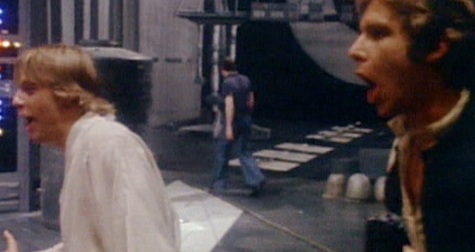
Other Oddities
- Droids are referred to as ’Droids, assuming that everyone understands this is a slang abbervation for the word “android.”
- The references to Earth crop up here and there. The “duck” mentioned above in the Obi-Wan section is an obvious example, but even in that same part of the book we get this sentence: “Luke’s mind was as muddy as a pond laced with petroleum.” Now that imagery would be weird even in a regular novel.
- It’s a bit unclear if Han shoots first in terms of the altercation between himself and Greedo in the cantina. Yes, it’s made plain that Han kills Greedo, but there is nothing there to say that maybe Greedo didn’t also fire. From the text: “Light and noise filled the litte corner of the cantina, and when it had faded, all that remained of the unctuous alien was a smoking, slimy spot on the stone floor.”
- The novel ends with Luke having lovey-dovey feelings about Leia. There’s no mistaking this—it’s not subtle at all: “Luke found that his mind was neither on his possible future with the Alliance nor on a chance of traveling adventurously with Han Solo and Chewbacca. Instead, unlikely as Solo claimed it might be, he found his full attention occcupied by the radiant Leia Organa. She noticed his unabashed stare, but this time she only smiled.” So, not only does Luke have a big crush on Leia, but he was also maybe considering going off on adventures with Han? Now, at least that part is kind of awesome.
There’s a lot more in this book which is off, awkward, and not at all like the film version of Star Wars: A New Hope, and yet the book is highly readable. To say it’s worth reading even if you haven’t seen the movie would be the claim of a crazy person, but if you like Star Wars, this novel will offer a bizzare glimpse into an alternate and twisted version of galaxy far, far away.
But you’ve been warned: if you face this novel, you face it alone. I cannot interfere.
Ryan Britt is a staff writer for Tor.com.



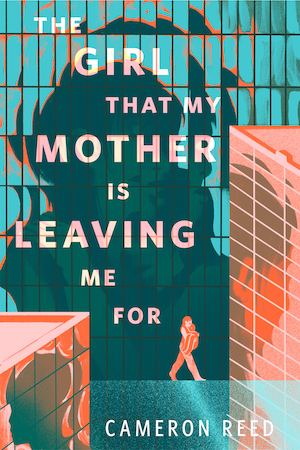
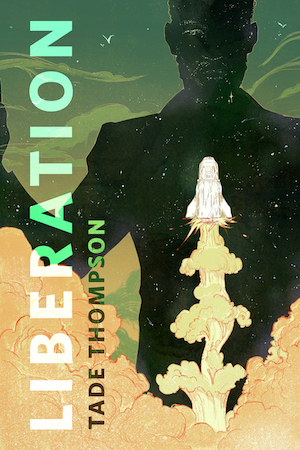





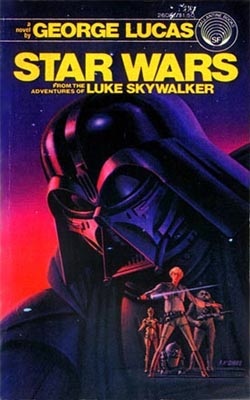
Luke also died in the altercation with the Sand People, cuz Artoo is very worried about him.
I always read the version of the Emperor that the populace learned from the history books, and the one seen in TESB and ROTJ to be a deliberate characterization, so that the people didn’t know that the Emperor was responsible.
Eh, chalk it up to Early Installment Weirdness. Though I do enjoy one of the lines you didn’t mention, the epigraph to the novel:
“They were in the wrong place at the wrong time. Naturally, they became heroes.” –Princess Leia Organa
Another interesting viewpoint of the original film is the public radio performance of it. It includes the Biggs scenes, a lot more on Tatooine, and really fleshes out the story. It was written by Brian Daley, who also did the great Han Solo series set in the Corporate Sector.
Nothing new here.
The german paperback edition of the early 90s 3-part-omnibus was my first Star Wars book, a few years before the continuation novels, and was exactly the described version. I always knew these “added informations” to the original trilogy.
The reason for the squadron designation color change was that the blue flashings on the “Blue Squadron” X-Wings would have been problematic for the bluescreen model shoot (likewise all of Artoo’s blue ‘trim’ is black in the deathstar sequences shot against a bluescreen).
So Blue Squadron became Red Squadron and Red became Gold. This was obviously a change made late in shooting as most of the pilots in ‘Red’ squadron still have blue Alliance Starbirds on their helmets.
I seriously thought the Journal of the Whills was a real book when I was a child, I even wrote the Library of Congress looking for it.
Mainly because of that Leia line.
You missed the one where Jabba is clearly a humanoid of some sort in his standoff with Han and Chewie in the Mos Eisley spaceport.
#7 He was also cast that way in the film. They shot that scene and later cut it. They used it in the re-release, (Blasphemous as it is), and added the RotJ Jubba.
I suspect you either have or will cover this in another post, but the sequel to this book, Allen Dean Foster’s 1978 “Splinter of the Mind’s Eye” is directly related to this book, and not – in any direct sense – the movies. As it was full of Luke/Leia stuff, Vader wackiness, the Force being treated like gravity or magnetism, and basically ties Star Wars to the Cthulhu mythos… it was sadly NOT made into the second movie.
The two books together present a sort of “alternate history” of the Star Wars universe that I really really loved as a kid. The only thing that feels similar is the Marvel Comics Star Wars series from the late 70s and early 80’s, they were totally riffing on this vibe.
Having listened to the public radio version of Star Wars 1.5 times in the last month (I have a 4-year-old), I’ve been meaning to reread the book to see how many of the differences between the radio show and the movie are also in the book. Notably the radio show has scenes of Luke drag racing through Beggar’s Canyon and Leia acquiring the Death Star plans…
And then there is Foster’s next (largely forgotten) Star Wars book Splinter of the Mind’s Eye in which Luke and Leia are most definitely an item…
Yep – in _Splinter_ he gets warm from Leia’s proximity, and contemplates their relationship…
I don’t think the idea of ducks existing in the GFFA is any crazier than humans being there, really. Luke just doesn’t know what one is because he’s lived on Tatooine his whole life (essentially.) And petroleum, well, that’s just naturally occurring. No problem there.
The “Journal of the Whills” bit came from a conceit about an in-universe document that Lucas used in early script drafts, sort of like Tolkien’s “Red Book of Westmarch.” Fans speculated endlessly about who or what the Whills were, some believing they were Yoda’s race (Jossed!). In the novelization of Episode III, Qui-Gon tells Yoda that the Whills discovered how to preserve their spirits in the Force after death.
Ah yes, I remember Splinter of the Mind’s Eye quite well. I read it and Foster’s novelization a number of times growing up, as well as Brian Daley’s first Han Solo novel. I later learned that Lucas commissioned SotME with an eye toward using it as the basis for a low-budget sequel if the film didn’t do too well. Of course, the film was immensely more successful than anyone anticipated, so they were able to do a big-budget sequel and Splinter was left by the wayside.
Interesting… and I do remember the ‘duck’ line, now that you mention it, but I didn’t read it as ‘confusion’ at all. More like, here’s a guy with vastly more experience and seen a heck of a lot more of the galaxy than Luke has… Not From Around Here.
@15: As I read it, Luke didn’t know what a duck was because he grew up on a desert planet and thus wouldn’t be acquainted with waterfowl.
As someone who remembers the novel as very engaging (through the fog of memory, albiet) I’ve always felt the ADF never got enough credit for his contribution to the SW mythos.
@Everyone interested in us talking about SPLINTER OF THE MIND’S EYE; just you wait. Myself and Emmet Asher-Perrin are cooking things up now. MUDFIGHT.
@17. It’s actually shocking how much influence ADF has on a lot of big sci-fi universes. Star Trek owes a huge debt to him!
@19: What do you mean? Foster memorably novelized and expanded on the animated Trek, and he’s been brought back to novelize the Abrams movies, but his only contribution to onscreen Trek is writing the story outline that was the basis for Star Trek: The Motion Picture.
@20 I guess, I mean I was personally influenced by those animated-Trek books! And, I sort of love Star Trek: The Motion Picture, totally
unabashedly.
@3 I truly love the NPR drama. I had it on cassette and played it on my Walkman whenever possible. Brock Peters is a suprisingly good Vader!
@21: I agree, but I was thinking more of the big picture, I guess.
@3 There’s also an awesome scene in the radio drama where Leia has a run-in with Vader prior to the start of the film. Not to mention the scene when her and her Dad kill an Imperial Officer when he’s having dinner with them!
@7
I skipped the Jabba stuff because it’s so well known, and it isn’t SUPER interesting to me. But yes, I remember being baffled as a child because the version of the book I had featured pictures of a human “JABBA.” :-)
@@@@@ 2. Yeah, that epigraph from Leia has always been my go-to definition of “hero” (sorry, Mal).
“Pond full of petroleum” actually makes a kind of sense, given that Luke is a moisture farmer; I’d imagine that a moisture vaporator could easily break and start leaking toxins into its reservoir (thus ruining a good chunk of the harvest). Luke’s probably seen a few pools of dumped-out waste water, probably associated with Uncle Owen’s voluminous cursing.
I wouldn’t necessarily call it weird or funny. Those discrepancies are there because Lucas changed things and made things up as he went – the emperor really was just a figurehead in the early SW material, the Sith stuff came later; Luke and Leia were obvious romantic matches, the sibling stuff and Darth Vader being their father only came up in making _Empire Strikes Back_, etc.
If anything, one should be thankful that these traces survive, since they help reconstruct the gradual historical development of the Star Wars universe (no thanks to Lucas’s endless revisionism and ‘oh it was always the Tragedy of Darth Vader’).
@28: Yeah, novelizations often used to reflect earlier drafts of the script, due to the long lead time for novel publication. And conversely, novelizers were freer to add their own new material, so it could be hard to tell what came from the script and what came from the novelist. These days, for whatever reason, studios are much stricter about having novelizations accurately reflect the final cut of the film — which is odd, because what’s the point of a novelization that doesn’t contain anything new?
I have no problem reconciling the portrayal of the Emperor in the novel with the Emperor in the movie, as what is portrayed in the book is exactly the image that Palpatine wanted to portray to the world at large. The public of the Empire didn’t have the benefit of watching the Prequels like we did!
A good novelist gets to show internal monologues and backstory and other details that don’t fit the media of film, so even if they share the same source, a good novel should not match a good movie. Each form requires a different approach. For example, building the character of Biggs works well in the novel, but would have slowed the pace and distracted in the movie.
I didn’t read the novel until years later, after ROTJ, and the portrayal of Luke’s longing for Leia at the end just creeped me out.
And lastly, I am glad to see the NPR radio dramas mentioned–it is one of my favorite portrayals of the tale.
I have no problem reconciling the portrayal of the Emperor in the novel with the Emperor in the movie, as what is portrayed in the book is exactly the image that Palpatine wanted to portray to the world at large. The public of the Empire didn’t have the benefit of watching the Prequels like we did!
A good novelist gets to show internal monologues and backstory and other details that don’t fit the media of film, so even if they share the same source, a good novel should not match a good movie. Each form requires a different approach. For example, building the character of Biggs works well in the novel, but would have slowed the pace and distracted in the movie.
I didn’t read the novel until years later, after ROTJ, and the portrayal of Luke’s longing for Leia at the end just creeped me out.
And lastly, I am glad to see the NPR radio dramas mentioned–it is one of my favorite portrayals of the tale.
“Benefit” of watching the Prequels. :p
Ha ha, I see your point, Cybersnark.
I’m surprised you didn’t mention Red Leader’s line about having flown with Luke’s father during the war. I thought that made it into the novelization. Even in the restored scene in the movie, you can see where they had to cut that bit out…A guy walks in front of the camera while they’re talking, and after he’s past, Artoo has suddenly jumped a great deal in his ride up to the X-Wing.
I actually read Splinter without encountering this earlier novel. It was… interesting.
@18 – Oh, yes, the mud fight. Don’t remind me.
Although I have a copy of this book, and actually was reading it (or starting to–got distracted) a few months ago, I really remember Splinter of the Mind’s Eye much better. It was the first Star Wars novel I read, back in the early 90’s, and I loved it. I always thought it was a better, more believable version of the story than what we find in the other EU novels, even with its discrepancies as compared to the movies. Having read the majority of the later novels, I can say that there are many scenes and plot threads that I liked; but overall, the later stories are ruined by their repetitiveness–that is, on the larger scale, they are telling the same story over and over. In every “generation”, it’s the story of a new manifestation of the empire being overcome–and often augmented, as well–by a minimal group of Force users. It’s essentially the original trilogy, again and again, but with the shine long since rubbed off. The ADF novels, along with Brian Daley’s early Han Solo novels, demonstrated from the very beginning that you can tell another story, a different story, in the Star Wars universe, and tell it well. For that, I’m grateful–and I’ll always favor those books.
and yet the book is highly readable.
Well, maybe if you’re 12.
You are joking, right? I remember this thing (though only vaguely) as being well-nigh insufferable — on par with reading Gene Roddenberry’s treatment of Star Trek: The Motion Picture* — and learning that Alan Dean Foster wrote it disappoints me greatly, as I remember reading a number of his other efforts (the animated Star Trek series and his Pip novels, particularly) with some fondness.
Its only saving grace was that it was incalculably (12 parsecs at least!) better than Donald Glut’s execrable adaptation of The Empire Strikes Back, which I seem to recall making it through about 3 pages of before throwing it across the room.
* You will probably now tell me that Foster ghost-wrote that as well, and force me to go off and have a drink or something to dull the pain.
@38: There is a common misconception that Foster did ghostwrite the Star Trek: The Motion Picture novelization, but it’s totally wrong. The writing style of the TMP novel is completely unlike Foster’s, and is consistent with the work of a screenwriter who’d never written in prose before. (Its writing style is somewhat stilted and has some scriptlike elements, such as an excessive use of italics; in scripts, underlining or other emphasis is used heavily to call attention to descriptions or stage directions that the director, production designer, etc. need to be aware of.) Its content also reflects Roddenberry’s personality and preoccupations, including his sexual fixations as well as his utopian futurism.
There are probably two reasons for the myth that Foster ghostwrote the TMP novel. One, I assume, is confusion with the Star Wars novelization, since they came out only two years apart. The other is that the French translation of the TMP novel listed the writing credits incompletely; it was supposed to say the novel was by Gene Roddenberry based on the screenplay by Harold Livingston and the story by Foster, but the translation left off the Roddenberry and Livingston credits by mistake.
The ‘what’s a duck’ line is one of my favorite parts of the novelization.
If I recall, in the Return of the Jedi novelization, Owen and Obi-Wan are brothers.
Nomad @38: “Well, maybe if you’re 12.”
Hindsight is a wonderful thing, isn’t it?
I was 12 and, like the movie, it hit me right in the demographics. It remains the only book I’ve ever read literally unto destruction: the paperback binding fell apart in less than three weeks during January 1978.
Learned two new words, gargantuan (the Death Star) and melliflous (Leia’s voice in the briefly-glimpsed recording).
Changed my life.
Bought a second copy of the book later that year, but even then the revisionism had begun – there were subtle differences between the original text and the newer version.
@41: Yeah, Foster’s Star Trek Logs taught me a lot of vocabulary words when I was a kid.
I thought the Luke/Leia stuff in the book was less weird since Luke is described as 22 years old and Leia is 19. No way they are twins.
In early 1977, I saw the novelization on the rack at Sun Drug in Glen Cove, Long Island. While the “soon to be a motion picture” tag intrigued me a bit (SF movies of any quality were rare in the 70s), the story description gave me a “Meh.” I was reading Poul Anderson and Larry Niven books and playing sophisticated SF wargames, and it all sounded kind of trite.
Then I saw the trailier. It is hard to describe how utterly cool and slick Star Wars looked (and sounded!) compared to the other SF movies of the day. If I didn’t buy the book on the way home from the movies in downtown Glen Cove, the purchase was made witihin a day or two.
After reading the book I was still kind of Meh, but I was still utterly cranked about seeing that movie.
I still have that copy of the book, with its purple cover and crude cover illos, and another a friend of my father got for review purposes.
* * *
I don’t think the differences between the movie and novelization, and to Star Wars canon, are at all puzzling or weird:
A) ADF got copy of the script, maybe saw some storyboards, and churned out a novelization, filling in gaps with his own workmanlike worldbuilding, just as he had been doing with his Star Trek animated series novelizations.
B) At the time the first movie was written, Lucas likely hadn’t decided that Palpatine was a Sith, or that Vader was Luke’s father, or that Luke and Leia were siblings, or a zillion other things we now know about the Star Wars universe. He was making it up as he went along, people! You can’t blame Foster for not knowing these things when Lucas didn’t.
@44: The concept of “the Sith” was never defined in the original trilogy anyway. The Foster novelization referred to Darth Vader as “Dark Lord of the Sith,” but the term was never used onscreen until The Phantom Menace (though it was used in the comics before then, apparently).
@45: I remember when Vader was referred to as “The Dark Lord of the Sith” in the extra-movie material, as though he were the only one. In fact, I seem to remember referring to Dark Side Force users as “Dark Jedi” with my friends (even if that weren’t essentially true). I can’t recall now, but we may have referred to Palpatine as a Dark Force user. We certainly weren’t calling him a Sith Lord that I recall. Even Decipher’s Star Wars CCG had cards like “Dark Jedi Lightsaber” instead of “Sith Lightsaber.” I looked up the Tales of the Jedi comics series, and they did come out before the prequels, like I thought. So the Sith was definitely a concept in there before Phantom Menace, but I still don’t think my circle of friends caught on to calling Palpatine a Sith Lord before the film.
@46: Right. I gather that Lucas took the name “Sith” from a race of creatures in Burroughs’s John Carter of Mars series, so I suspect that the Sith may have originally been vaguely intended to be some race or nation that Vader ruled over. Before Lucas decided to make Vader Luke’s father, perhaps he meant the Sith to be the species that Vader belonged to. (There’s a claim out there that “Darth Vader” was supposed to be based on “Dark Father,” but it seems pretty clear that Lucas originally based it on “invader” — an idea reinforced by the name “Darth Sidious,” constructed in the same way.)
No, it is based off of a dark father, the hero was supposed to have two fathers, one good one evil(Obi-Wan and Vader) but I guess he realized he didn’t want to get into the biology of HOW that was possible(and thank god too, cuz after midiclorians I don’t trust that man around the science part of science fiction) so he cut it. He just didn’t change the name after he dropped the paternal storyline, and it ended up working out, because he made the call to reinstate Vader as his father.
“even a duck has to be taught to swim.”
Really?
Having just finished reading it, I can also add another– Artoo doesn’t roll. He waddles and hops. His feet are also referred to as clawed at one point.
In the original novelization of “A New Hope,” the captain of Princess Leia’s consular ship, the Tantaive IV, was Captain Colton. In the film and later versions of the novelization, his name was Captain Raymus Antilles.
@51: The name Tantive IV hadn’t even been coined yet then, had it? I read the novelization plenty of times as a youth, but I never heard that name for the ship until the prequel trilogy, I think. I don’t recall what the novelization called it, but other sources at the time consistently referred to it simply as “the Rebel Blockade Runner.”
And of course it wasn’t the novelization of A New Hope, because that subtitle wasn’t added until the 1980 re-release. It was the novelization of Star Wars. And as the above article says, its full title was Star Wars: From the Adventures of Luke Skywalker — treating Star Wars itself as the episode title, it seems, rather than as the series title. If Lucas hadn’t changed his mind, the second movie might’ve been The Empire Strikes Back: From the Adventures of Luke Skywalker. And so on — though one wonders what the prequels would’ve been called in that case.
@52: The Phantom Menace: From the Adventures of Luke Skywalker’s Dad.
@52 – According to wikipedia, the NPR Radio Drama gave it the name Tantive IV. I know I had definitely referred to it as such before the prequels came out, so the name was out there.
@54: Okay, but the radio drama came out five years after the novelization, so my point stands: the novelization itself did not use that name for the ship.
Yes, true – it was just called a blockade runner in the novelization, but your comment made me curious as to where the name came from.
I read the book roughly a year before seeing the movie. I had discussions with other fanboys without seeing the movie. They didn’t know that if I didn’t tell them.
Thanks for bringing back good memories.
In the original script for Empire, Darth Vader had a secret hideout inside of a volcano, populated by little gargoyles, that he would use for meditation. THAT would have been awesome!
I got this novel the spring before the movie came out from the book club at my elementary school i was 11 and in 5th grade i think, i remember starting to read it at recess and loving it. As some one who was devouring the Heinlein juveniles at the time it hit a perfect sweet spot. I do remember thinking that it was authoritative over the movie till Empire came out. my copy had a gold cover with the a movie poster type image on tho. i also remember how much of a side character han was he wasn’t even on the cover.
The weirdest thing about _Splinter_ was that Luke could swim and Leia couldn’t. You’d kind of expect the reverse (and it was the reverse in the Marvel comics).